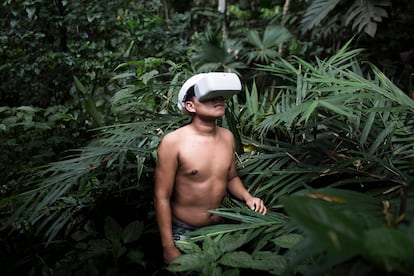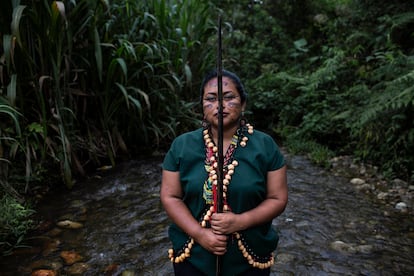Poachers, miners, Covid-19: indigenous protection teams face new challenges in the Amazon jungle
Self-organized patrols protecting native communities from illegal activities are now also dealing with assassination threats against people with coronavirus as well as growing government hostility

The approximately 700 members of the Siona people, who live in an area of jungle extending through parts of Colombia and Ecuador, have a guard system of their own that keeps them safe from the armed conflict surrounding them. Their last intervention saved the lives of individuals with Covid-19 who were being targeted by armed groups aiming to kill them in order to contain transmission, according to Mario Erazo, coordinator of a security corps that had to redouble surveillance to prevent violent intruders from entering their territory and carrying out their deadly mission.
“When we heard that the virus was already close, the armed men said, ‘We cannot allow it to spread here, and anyone infected with it, well, they have to die at once. How? With a bullet,’” says Erazo. “The situation was difficult; we were afraid that the disease would reach us, but we were even more afraid that they would kill us for having contracted it.”
The Siona guards, known as cuiracuas in their native language, have been protecting their community all their lives. Erazo talks about the boa and the tiger that, according to local tradition, look after the water and the land, but he also talks about the community’s need to form a more organic surveillance system around 10 years ago. “Our taitas (parents or elders) took care of the territory spiritually through the boa and the tiger,” he says. “But we had to look for a more effective strategy to deal with the range of situations being experienced by the two countries that affect the indigenous territories. So we have become visible caretakers.”
This visibility has led them to mediate with Colombia’s armed groups, such as FARC dissidents and other criminal gangs who want to enter indigenous territory to hide from the regular armies, recruit young people and impose coca leaf cultivation. According to Erazo, they have a lot of resources and they give money and even seeds to the peasants so they will plant coca. “If you say ‘no, I don’t want to plant it’ then you either leave or you die,” he adds.
The indigenous guards have emerged from the self-governance of the native peoples of Latin America. They are accustomed to taking yagé, the ancestral medicine also known as ayahuasca, which is meant to given them the wisdom to guide their people. Their main mission is to protect the territory they have been able to recover from colonialism. They use spears, another weapon known as a bodoquera and batons to deal with the threats coming from outside. In recent years, they have also used GPS, drones and cameras to document the damage caused by the extraction of raw and natural materials. And in areas mired in armed conflict, as in Colombia, they act as mediators and agents of peace.

The Cofán people’s indigenous guard is part of a community made up of 200 people living on the banks of the Aguarico River. It was formed in 2017 and has its own law to control the presence of illegal miners and poachers.
In 2018, using GPS, drones and cameras delivered by the Ceibo Alliance, an association of four Amazon nations, they managed to document the environmental damage from mining activity going on behind their backs. Further investigation revealed that the Ecuadorian state had granted mining concessions without getting permission from the affected communities as stipulated by the Constitution. The indigenous community took the case to court and succeeded in reversing 52 mining operations covering an area of 32,000 hectares.
Alexandra Narváez, a member of this security corps, talks about the discovery and what the land means to them. “We found the big mining companies inside the river,” she says. “They were digging and taking out stones. We had not seen that before. We were surprised to see their machines, which led us to unearth the mining concessions that no one had ever told us about. The only thing that happened was that the president of the parish council sent us a document so that the miners could give us chickens and gifts for Christmas, but we didn’t sign anything. Our territory is our home; if they damage our home, where are we going to live? What are we going to leave for our children? They are destroying our lives.”

The Siona and Cofán found inspiration in the indigenous guard of the Regional Indigenous Council of Cauca (CRIC), which brings together 10 native peoples in Colombia and has had its own surveillance operation for 50 years. It is made up of 7,000 men and women who define themselves as a peace corps. Jhoe Sauca, from the Kokonuko ethnic group, explains how the entity came about. “The poppy boom of the 1990s meant that armed groups from both sides began to carry out assassinations again,” he says. “So we had to act as they kept killing our people. Both the army and the guerrillas were also using seductive techniques on the indigenous communities to then use them as informants, and that was putting the communities in danger.”
The CRIC’s improvised army gradually became the first school for both political organizational training and the promotion of human rights in the territories. But these are not good times for self-protection in Colombia. With the FARC, there was a certain amount of respect, according to Sauca, but now they are being attacked from all sides. “Now they assassinate the guards,” he says. “They see them as the enemy; they say we make government policy because we capture dissidents, but the government also accuses us of being guerrillas.”
The stigmatization of the indigenous guards is not specific to Colombia. At the beginning of this year, Ecuador’s then-defense minister Oswaldo Jarrín, linked them to the border guerillas. María Lina Espinosa, a lawyer with Amazon Frontlines, explains that there is an interest in delegitimizing the organization of indigenous communities. “They want to make them appear to be a threat to the standard concept of sovereignty,” she says. “They want to make them look dangerous and harmful.”
Espinosa states that this stance could lead to persecution, resulting in legal proceedings that would put an end to the indigenous peace corps. But if the indigenous guards that protect these remote territories in Ecuador and Colombia are stamped out, who will take their place? “Attempts are being made by the army to enter their territories without respecting the control of the guard and the community decisions,” says Espinosa. “There is a movement against the coordinators and leaders, and also against the legal representatives who accompany them. In fact, the ex-minister himself is suggesting we have an interest in protecting drug trafficking and narco-paramilitary groups, and that this is why we exist. And there is a serious risk that this criminalization will end up in judicial processes.”
English version by Heather Galloway.
Tu suscripción se está usando en otro dispositivo
¿Quieres añadir otro usuario a tu suscripción?
Si continúas leyendo en este dispositivo, no se podrá leer en el otro.
FlechaTu suscripción se está usando en otro dispositivo y solo puedes acceder a EL PAÍS desde un dispositivo a la vez.
Si quieres compartir tu cuenta, cambia tu suscripción a la modalidad Premium, así podrás añadir otro usuario. Cada uno accederá con su propia cuenta de email, lo que os permitirá personalizar vuestra experiencia en EL PAÍS.
¿Tienes una suscripción de empresa? Accede aquí para contratar más cuentas.
En el caso de no saber quién está usando tu cuenta, te recomendamos cambiar tu contraseña aquí.
Si decides continuar compartiendo tu cuenta, este mensaje se mostrará en tu dispositivo y en el de la otra persona que está usando tu cuenta de forma indefinida, afectando a tu experiencia de lectura. Puedes consultar aquí los términos y condiciones de la suscripción digital.
More information

The Bolsonaro playbook: how to dismantle a democracy in slow motion
Archived In
Últimas noticias
Most viewed
- Sinaloa Cartel war is taking its toll on Los Chapitos
- Oona Chaplin: ‘I told James Cameron that I was living in a treehouse and starting a permaculture project with a friend’
- Reinhard Genzel, Nobel laureate in physics: ‘One-minute videos will never give you the truth’
- Why the price of coffee has skyrocketed: from Brazilian plantations to specialty coffee houses
- Silver prices are going crazy: This is what’s fueling the rally









































